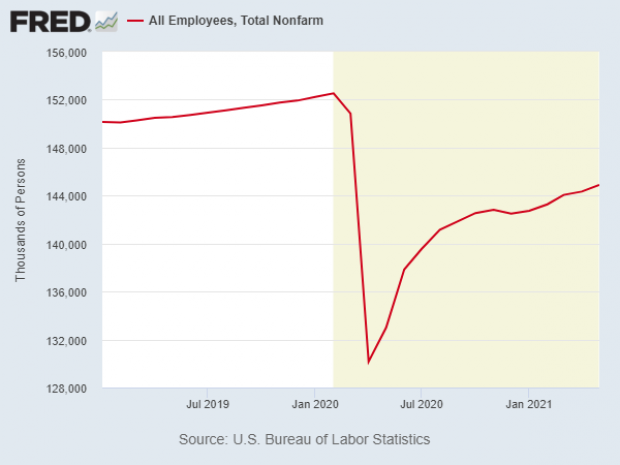The U.S. economy added 559,000 jobs in May, the Bureau of Labor Statistics announced Friday in a report that managed to be both reassuring and disappointing at the same time.
On the positive side, job growth in May was significantly stronger than it was a month earlier, and the unemployment rate dropped three-tenths of a point to 5.8%, the lowest level since March 2020. The jobs numbers are moving in the right direction, increasing confidence that the economic recovery from the Covid-19 pandemic is gathering momentum.
Job growth was weaker than expected, though, with many economists hoping to see more than 670,000 jobs added in May. And the labor participation rate was little changed, suggesting that millions of workers remained on the sidelines last month, despite growing demand that is beginning to show up in significant wage increases.
“On the surface, yes, the jobs numbers were strong, a half million jobs is obviously a good thing, but given where we are in the economy, all else equal it could have been stronger,” economist Michelle Meyer of Bank of America told Bloomberg News. “The fact that it wasn’t is likely a function in large part to supply constraints and labor shortages.”
White House takes credit: Speaking to reporters in Delaware, President Joe Biden was quick to link the solid jobs growth to his policies, including a major push for vaccinations, enhance unemployment benefits and direct relief payments for millions of Americans, which he said have boosted the recovery.
“[W]e have now created over 2 million jobs in total since I took office — more jobs than have ever been created in the first four months of any presidency in modern history, triple the rate of my predecessor, eight times the rate of President Reagan,” Biden said. “No other major economy in the world is growing as fast as ours,” he added. “None of this success is an accident; it isn’t luck.”
At the same time, the economy faces a number of hurdles, including a lack of childcare for workers and the long-running problem of wage inequality. “These challenges are also reflected in our jobs data, and they are why the American Jobs Plan and the American Families Plan are so important,” Secretary of Labor Marty Walsh said. “We need to invest in our workforce and our communities to achieve an inclusive recovery and a competitive economy.”
Republicans will disagree: Still, the strength of the report could work against the president’s push for more long-term spending on infrastructure and social welfare programs. “[T]he faster pace of job creation will offer a window for Republicans to say that the federal government does not need to spend a great deal more than the trillions of dollars already pumped into the economy since the virus swept through the country with startling speed last March,” Politico’s Ben White and Rebecca Rainey wrote.
The bottom line: The economy is growing but the pace is disappointing, and although there are clear improvements, there are also signs that we have a long way to go before returning to anything like normal conditions in the labor market.
“[T]he economy still remains 10 million jobs short of its pre-pandemic trend,” wrote economist and former Obama administration official Jason Furman. “At May’s pace of job growth it will take until August 2023 to close the jobs gap, and maintaining the May pace will be difficult as the lower hanging fruit of reopening is picked.”





